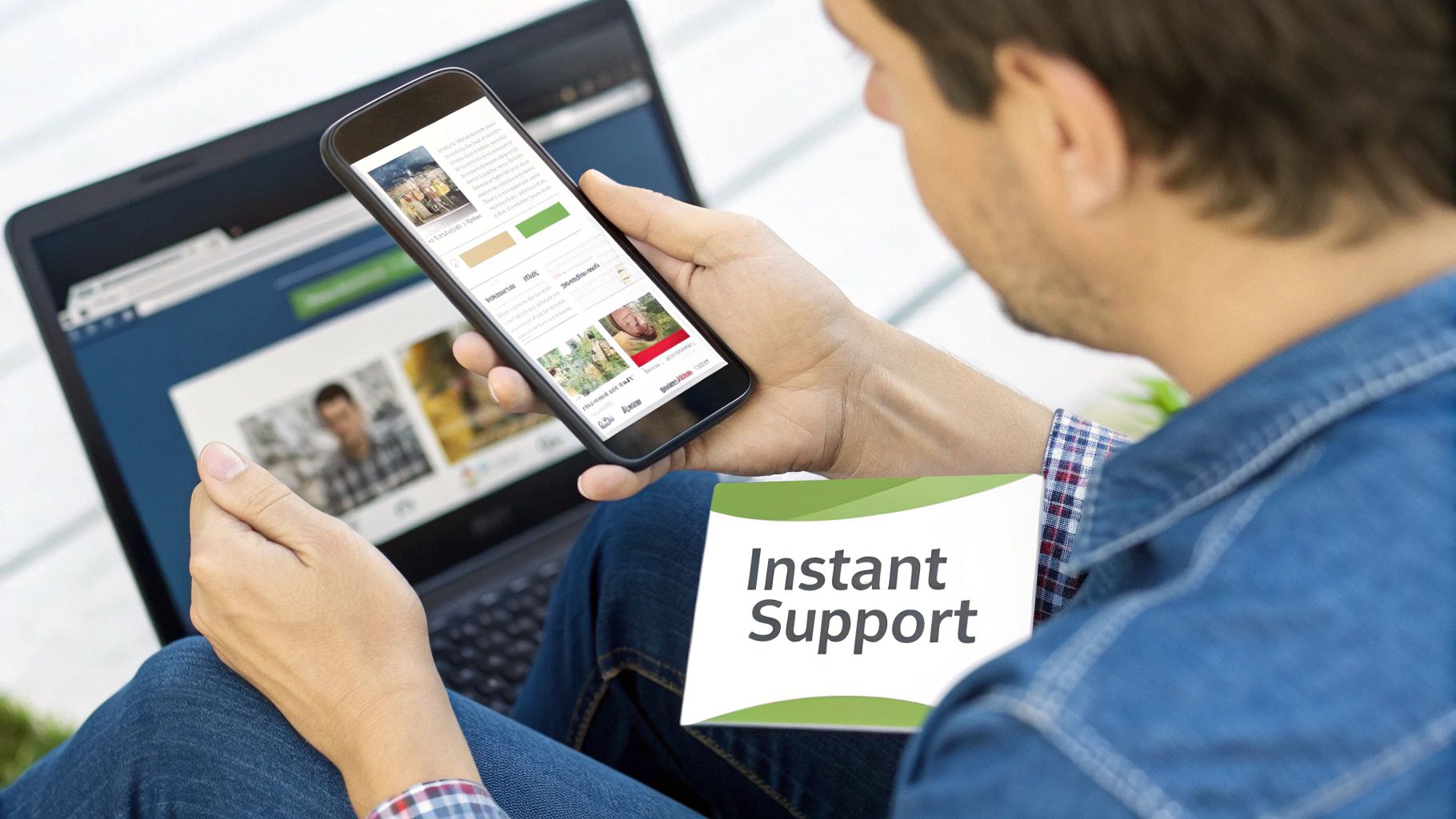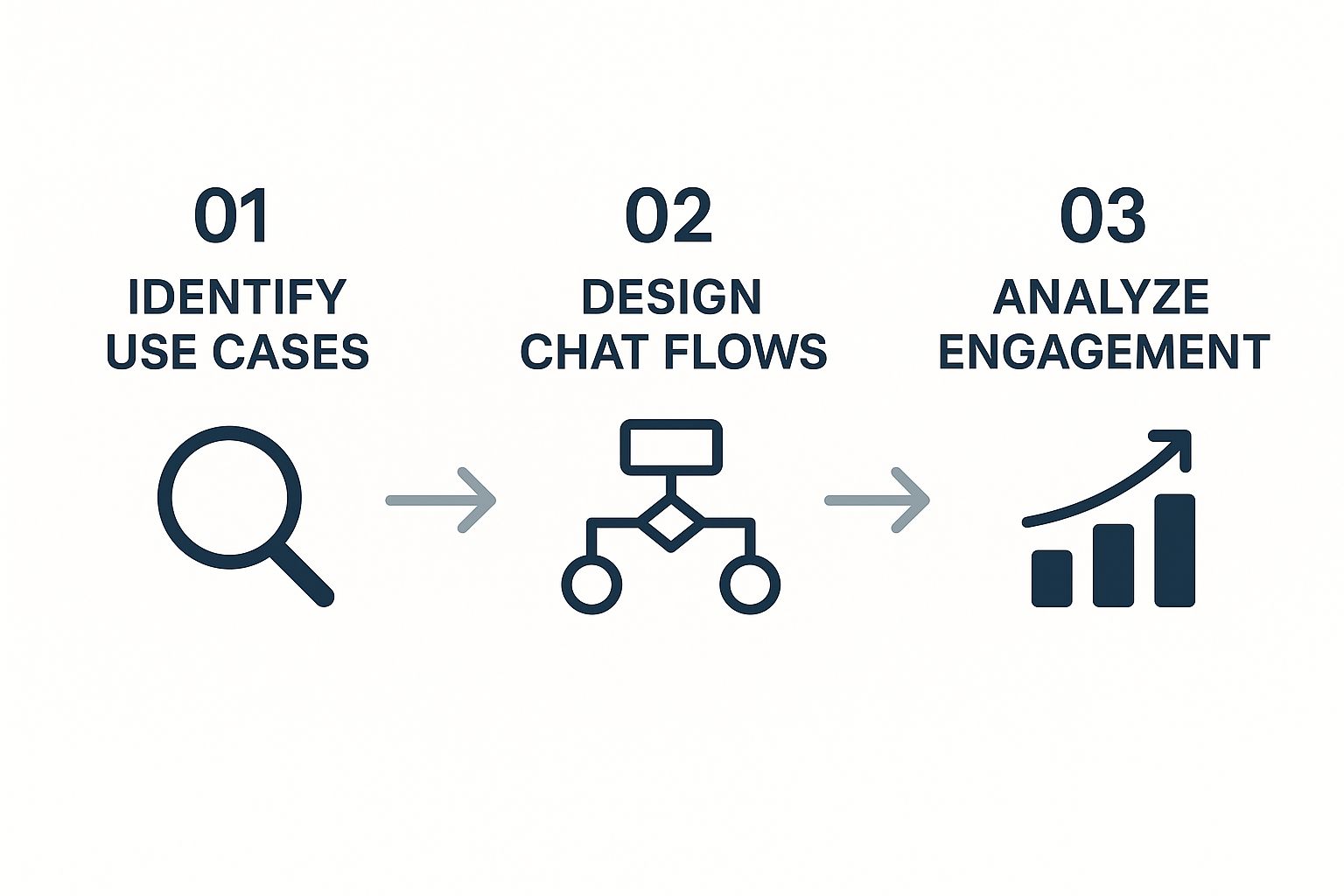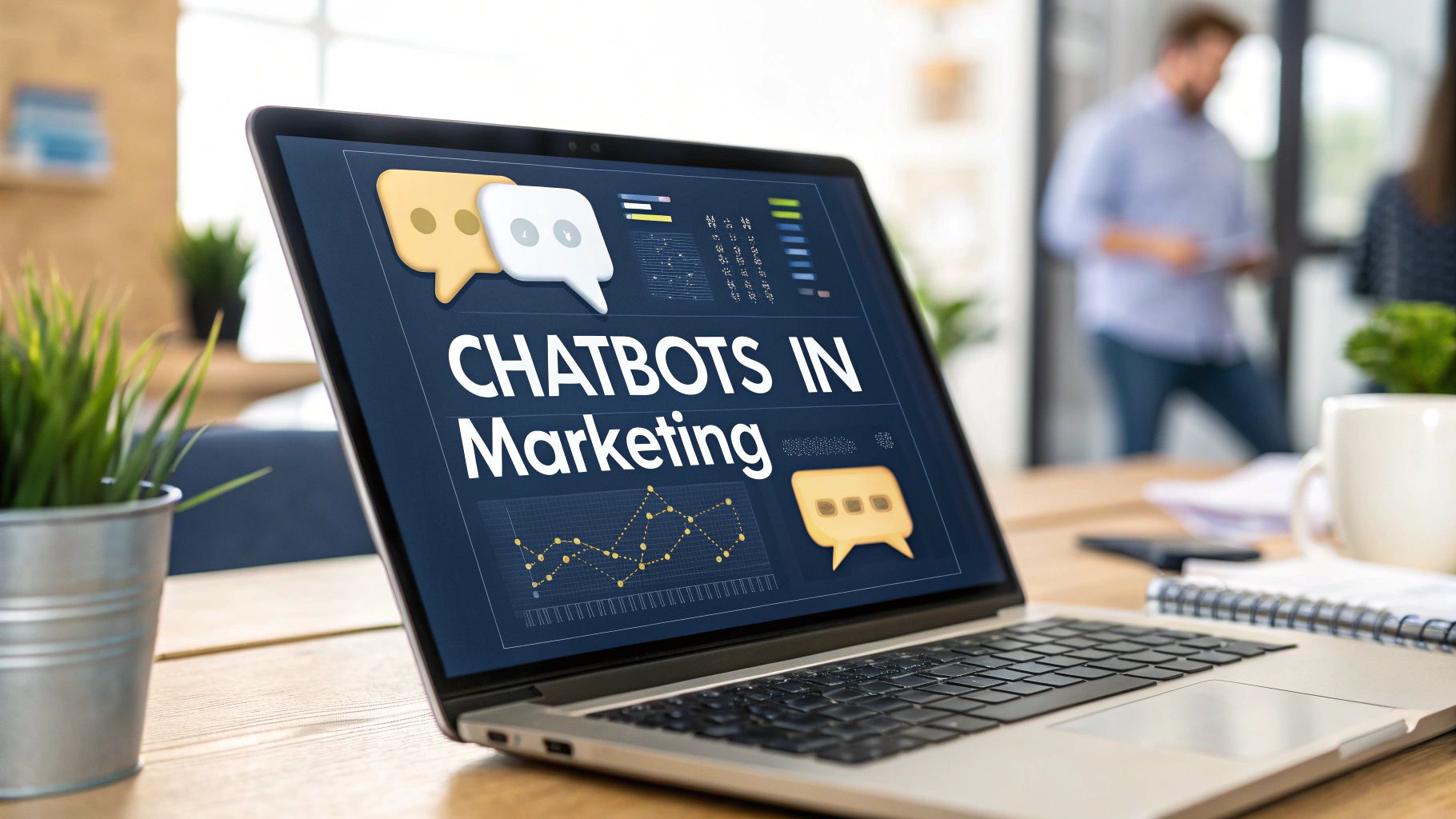Imagine your website for a second. Is it just a static, digital brochure floating in cyberspace? Or is it a buzzing storefront with a helpful assistant ready to greet every visitor, 24/7? That's the difference a marketing chatbot makes. They're no longer just annoying pop-ups; they are dynamic conversation starters that guide visitors and provide immediate answers.
How Chatbots Are Redefining Marketing Conversations
For a long time, digital marketing felt like shouting into the void. Brands blasted out messages through ads and emails, just hoping something would stick. Customers were on their own, left to wander through confusing websites trying to find what they needed. That old model is dying, fast. Today's customers expect instant, personal, and interactive help the moment they land on your page.
Chatbots mark a huge shift from brand monologues to genuine dialogues. Think of a standard website like a massive library where you have to hunt for the book you want. A marketing chatbot, on the other hand, is the friendly librarian who asks what you’re looking for and walks you straight to the right aisle and shelf. This simple conversational touch makes the whole digital experience feel more human—and way more efficient.
The Evolution from Scripts to Sophisticated AI
Let's be honest, early chatbots were pretty clunky. They were stuck on rigid, rule-based scripts. If you asked a question they weren't programmed to understand, you’d hit a dead end. It was frustrating and often made for a terrible user experience.
Thankfully, today's marketing chatbots—especially the ones powered by AI—are in a completely different league. They’re less like a bad actor reading a script and more like a skilled improv artist. They can grasp context, figure out what a user actually means, and even pick up on sentiment. This allows them to manage nuanced conversations and get smarter with every interaction.
A well-designed chatbot doesn't just answer questions—it anticipates needs, guides the customer journey, and builds a relationship with the user in real time. It's an active participant in the marketing process, not just a passive tool.
This leap forward is all thanks to some incredible tech growth. The global chatbot market has exploded, going from a niche tool to a must-have for marketers. In 2021, the market was valued at about $2.47 billion; by 2025, it’s expected to hit $15.57 billion. You can get the full scoop on this massive trend over at Exploding Topics.
Why This Matters for Modern Marketers
This move toward conversation isn't just a gimmick; it's a strategic imperative. It solves some of the biggest headaches for marketers, like qualifying leads, keeping customers engaged, and offering support that can actually scale.
By automating those initial chats, chatbots free up your human team to focus on the high-stakes, complex tasks. All the while, you can rest easy knowing that no potential customer is left waiting for an answer. To really grasp this, check out the game-changing impact of conversational marketing. It’s all about meeting people where they are—with instant, helpful, and personalized interactions that build real value.
What Can Marketing Chatbots Actually Do for You?

While the tech itself is cool, what really matters are the bottom-line results chatbots bring to your marketing. We're not talking about small tweaks here; these are major upgrades to how you find, connect with, and help your customers. Automating conversations opens up a whole new world of efficiency that used to be out of reach for most teams.
Think of a chatbot as your brand's ultimate digital concierge. It’s always on, never has a bad day, and can juggle thousands of conversations at once without ever dropping the ball. This isn't just about saving money—it's about scaling your marketing in a way that still feels personal and one-on-one for every single visitor.
Put Your Lead Generation on Autopilot
One of the biggest wins with marketing chatbots is how they flip lead generation from a passive waiting game into an active, engaging process. Your old contact forms just sit there, making the visitor do all the work. They have to find it, fill it out, and then wait… and wait.
A chatbot changes everything. It jumps into action the second someone lands on your site, acting like an expert sales development rep. It asks smart, qualifying questions to figure out a visitor's needs, budget, and if they're ready to buy. Based on those answers, it instantly sorts the hot leads from the window shoppers.
A great marketing chatbot can:
- Pinpoint high-intent visitors by asking things like, "Are you hoping to make a decision this week?"
- Automatically segment leads by their job title, company size, or what they're interested in.
- Book demos or calls right in the chat window by connecting to your team's calendars.
- Hand off sales-ready leads to a live person in real-time, so you never let a good opportunity slip away.
This whole process doesn't just speed up your sales cycle. It makes sure your sales team is only spending their precious time on leads that are actually likely to close.
Be There for Customers 24/7
In a world that never sleeps, the 9-to-5 workday is dead. Customers expect help whenever they need it, whether that's late on a Tuesday night or first thing Sunday morning. A marketing chatbot delivers that level of service without you needing to hire a massive, round-the-clock support team.
This constant availability means you capture every lead, no matter when they show up. For businesses with customers all over the world, this is a massive advantage. A chatbot can easily help people in different time zones, offering instant answers and support.
A key impact of chatbots in marketing is their proven ability to boost customer engagement and drive real sales conversions. In fact, about 33% of consumers are already comfortable using chatbots for things like booking reservations or placing online orders.
This is especially true for younger generations. With 40% of millennials using chatbots every single day, it's obvious that this kind of instant, digital-first conversation is the new normal. You can dig deeper into these trends and discover chatbot statistics and their impact on SlickText.
A Quick Look: Chatbots vs. Old-School Marketing
To really see the difference, let's compare a modern chatbot with the traditional digital marketing tools we've been using for years.
Chatbot Benefits vs Traditional Marketing Channels
| Feature | Chatbots in Marketing | Traditional Methods (Forms/Email) |
|---|---|---|
| Engagement | Proactive & conversational. Engages users instantly. | Passive & one-way. Waits for user to act first. |
| Response Time | Instant, 24/7. Answers in seconds. | Delayed. Can take hours or days for a human reply. |
| Lead Quality | Qualifies leads in real-time with targeted questions. | Collects basic info. Manual qualification is slow. |
| Personalization | Adapts conversation based on user responses. | Generic. One-size-fits-all approach. |
| Scalability | Handles unlimited conversations at once. | Limited by human bandwidth; expensive to scale. |
The table makes it clear: while traditional methods still have a place, chatbots offer a far more dynamic, efficient, and user-friendly experience.
Get More Done with Less
Finally, the ROI from chatbots goes way beyond just reducing headcount. Sure, they cut down on the need for a big team to answer the same questions over and over, but the real savings come from making your whole operation more efficient. A single chatbot can handle a volume of conversations that would be literally impossible for a human team.
This means you can grow your customer interactions without your costs ballooning. When things get busy—like during a big sale or a new product launch—a chatbot can handle the surge without breaking a sweat. Every customer gets a fast, helpful response, and your human agents are freed up to tackle the complex, high-value problems where they're needed most.
Powerful Chatbot Use Cases in Modern Marketing
Knowing the benefits of marketing chatbots is one thing, but seeing them in action is where their real power shines. We've moved way beyond simple FAQ bots. Today's chatbots are specialized tools built to solve real marketing problems, boost revenue, and create great customer experiences from the very first click.
Let's break down some of the most effective ways businesses are using chatbots to hit their marketing targets. Think of each use case as a mini-playbook for getting real, measurable results.
Qualify and Capture High-Quality Leads
One of the best things a marketing chatbot can do is completely overhaul your lead generation process. Forget making visitors hunt for a boring contact form. A proactive chatbot can jump in and engage them right away, acting like a friendly greeter for your sales team.
Picture this: a visitor lands on your pricing page. Instead of silence, a chatbot pops up. "Looking for a solution for a team your size? I can help you find the right plan."
Through a quick, natural conversation, the bot gathers key info:
- Company size and industry
- Their specific challenges or needs
- Budget and decision-making timeline
- Contact details like name and email
This feels more like a helpful consultation than an interrogation. By the time the chat is done, the bot has not only captured a lead but also qualified it. This means your sales team can stop wasting time and focus only on prospects who are a great fit. For a closer look at these strategies, you can learn more about how to automate lead generation and make your pipeline even more efficient.
Recover Abandoned Carts in E-Commerce
For any online store, cart abandonment is a huge headache that kills revenue. In fact, a staggering 69% of online shopping carts are left behind before the customer ever checks out. Marketing chatbots give you a dynamic way to tackle this problem head-on.
You can set up a chatbot to trigger the moment a user looks like they're about to leave the checkout page. It can start a conversation with a personalized message, like, "Hey, it looks like you left something behind! Can I help answer any questions about your items or shipping?"
By jumping in at that critical moment of doubt, a chatbot can clear up last-minute questions, offer a small discount to seal the deal, or just remind the shopper what they’re missing out on. This single interaction can be the difference between a lost sale and a loyal customer.
This proactive approach turns a potential loss into a sale, directly boosting your bottom line.
Drive Event Registrations and Engagement
Trying to get people to sign up for a webinar, workshop, or conference? A marketing chatbot can be your dedicated event registration assistant. Instead of sending people to a long, clunky sign-up page, the bot can handle the whole thing right inside the chat window.
It can start by building some buzz, sharing cool details about speakers, topics, and what people will learn. The bot can then field common questions about the schedule or pricing, removing any little hurdles that might stop someone from signing up.
Once a user is ready to commit, the bot can:
- Collect their registration info right in the chat.
- Instantly confirm their spot.
- Add the event to their calendar.
- Send out friendly reminders as the event gets closer.
This makes for a super smooth and interactive sign-up experience that boosts attendance and keeps your audience hooked from day one. To get your own creative juices flowing, check out these powerful ChatbotGen use cases for more ideas.
Personalize Product Recommendations
In a world full of options, personalization is everything. Chatbots are fantastic virtual shopping assistants, guiding customers to the perfect product through a simple conversation. It’s way more engaging than a generic search bar.
A chatbot on a retail site can ask a few smart questions to figure out what the shopper is looking for. For a clothing store, the bot might ask, "Are you shopping for a special occasion or something casual?" It could follow up with questions about color, fit, and budget.
Based on their answers, the bot can pull up a curated list of products—complete with pictures and links—creating a custom shopping experience that drives more sales and leaves customers feeling understood.
How Generative AI Is Upgrading Marketing Chatbots

The marketing chatbots we've been talking about have already been a huge help for businesses. But now, a new kind of technology is here, taking them from useful tools to genuine conversational partners. That technology is Generative AI.
Think of a standard, rule-based chatbot like an actor who can only say their memorized lines. It works fine, as long as the conversation follows the script. A generative AI chatbot, on the other hand, is an improv master. It doesn't need a script because it understands context, sentiment, and nuance, allowing it to create authentic, human-like dialogue in real time.
This ability to improvise makes conversations feel incredibly fluid and natural. It opens the door to a much deeper, more meaningful connection with your customers.
The Power of Dynamic Conversations
The real magic is in how these bots "think." Old-school bots follow a rigid path. If a user says "X," the bot gives response "Y." But if the user asks something unexpected? The bot stalls.
Generative AI is different. It uses powerful language models to grasp the intent behind the words, not just the words themselves. This allows it to tackle complex, multi-part questions and stay on topic even when the conversation zigs and zags.
For marketers, this unlocks a whole new level of possibility:
- Hyper-Personalization at Scale: An AI chatbot can recall past conversations and tailor its responses, creating a true one-to-one experience for every single user.
- Dynamic Content Creation: The bot can generate personalized product recommendations, create unique discount codes, or even write a follow-up email based on the chat.
- Complex Problem-Solving: It can troubleshoot tricky issues that used to require a human agent, walking users through multiple steps to find a solution.
This isn't some far-off future tech; it's rapidly becoming the standard. The numbers back it up: 77% of consumer devices now have some form of AI software baked in. When you look at generative chatbots specifically, their dominance is undeniable. As of mid-2024, ChatGPT holds a massive 75.0% market share. While that's a slight dip from 76.4% earlier in the year, it really just highlights the growing competition in this space. You can discover more insights about top generative AI chatbots and their market share.
Building Deeper Customer Relationships
At the end of the day, the goal of using chatbots in marketing is to build stronger, more loyal customer relationships. Generative AI makes this possible in ways we never thought an automated system could.
When a chatbot can understand a customer's frustration, share in their excitement, or offer a genuinely helpful and unexpected solution, it stops feeling like a machine. It becomes a trusted representative of your brand.
This fundamental shift allows marketers to automate conversations without losing the personal touch that builds real trust. It means you can scale your customer engagement and still make every single person feel seen, heard, and valued. This isn't just an upgrade—it's a complete reimagining of what automated customer interaction can be.
Building Your First Marketing Chatbot Step by Step
Diving into the world of marketing chatbots might sound like a job for a developer, but modern tools have made the process surprisingly simple. You don’t need to know a single line of code to build a bot that works for you 24/7. By breaking it down into a few manageable stages, you can get your first chatbot live and start seeing real results.
Let’s walk through how it’s done. We'll use a user-friendly platform, ChatbotGen, as our example to bring each step to life.
Step 1: Define a Clear and Measurable Goal
Before you even think about what your chatbot will say, you have to decide what you want it to do. A fuzzy goal like "improve our marketing" is a recipe for failure. You need a specific, measurable target that guides every single decision you make.
Start by looking at your biggest marketing headaches. Is your sales team drowning in junk leads? Is your support staff answering the same five questions all day?
Here are a few examples of strong, actionable goals:
- Capture 20% more qualified leads from our main services page this quarter.
- Cut down on common support emails by 30% by letting the chatbot handle them.
- Boost webinar sign-ups by 15% by making the registration process a simple conversation.
When you have a clear target, your chatbot stops being a gimmick and becomes a strategic tool built to solve a real business problem.
Step 2: Map the Conversation Flow
With your goal locked in, it’s time to plan the user's journey. Don't jump into writing scripts just yet. First, you need to visualize the conversation from beginning to end. Think of it like drawing a simple roadmap for the chat.
A visual flowchart is your best friend here. In a tool like ChatbotGen, you’d use a drag-and-drop builder to outline all the different paths a user might take. This map should include key decision points, the questions your bot will ask, and how it should react to different user responses.
If your goal is lead generation, for instance, the flow might go from a friendly greeting, to a few qualifying questions, and end with a clear prompt to book a demo.

Mapping it out visually helps you catch any dead ends or confusing loops before you waste time writing dialogue that doesn't work.
Step 3: Script a Compelling Dialogue
Now for the fun part: giving your chatbot a personality. The script is where you define your bot's tone of voice and write the exact words it will use. Remember, your chatbot is a direct extension of your brand. Its personality should match your overall marketing message—whether that's friendly, professional, witty, or straight to the point.
A great chatbot script does more than just fire off questions. It uses clear, concise language, offers helpful shortcuts with quick-reply buttons, and—this is crucial—always gives the user an easy way to talk to a human if they get stuck.
For anyone focused on turning conversations into customers, our guide on using a chatbot for lead generation offers much deeper insights and scripting examples.
Step 4: Integrate and Deploy Your Chatbot
Once your script is ready to go, the final technical hurdle is getting it live on your website. The good news is that no-code platforms make this incredibly easy.
Most of the time, the platform will give you a small snippet of code. All you have to do is copy that code and paste it into the HTML of your website. You don’t even need to understand what the code does; you just need to put it in the right place. Many platforms also offer one-click integrations with website builders like WordPress or Shopify, which makes it even simpler.
As soon as it’s deployed, your chatbot will appear on your site, ready to engage with visitors instantly.
Step 5: Test, Analyze, and Optimize
Launching your chatbot isn't the finish line—it’s the starting pistol. The most successful chatbots in marketing are the ones that are constantly being tweaked and improved based on real user data.
After your bot is live, you have to keep an eye on its performance. Pay close attention to these key metrics:
- Engagement Rate: How many of your site visitors are actually talking to your bot?
- Goal Completion Rate: What percentage of users are making it to the finish line (e.g., submitting their info)?
- Drop-off Points: Where in the conversation are people giving up and leaving?
These numbers will tell you exactly where to make improvements. If a lot of users are dropping off at a certain question, maybe the wording is confusing. Tweak the script, adjust the flow, and keep testing. This cycle of analyzing and optimizing is what turns a good chatbot into a great one.
Best Practices for a High-Performing Chatbot

Getting a marketing chatbot live is a great start, but the real magic happens when you optimize it. The line between a bot that people love and one that just annoԲs them is surprisingly thin, and it usually comes down to a few key principles.
Think of these best practices as the secret sauce that turns your bot from a simple tool into a genuine extension of your brand experience. It's not enough to just have a chatbot; it needs to be helpful, engaging, and in sync with your brand's voice.
Give Your Chatbot a Personality
A chatbot shouldn't sound like a machine spitting out pre-canned answers. It’s on the front lines, representing your brand. So, its personality should match. Are you a playful, witty brand? Or more professional and to the point? Decide on a clear tone and stick with it.
For example, a friendly bot might greet users with, "Hey there! What can I help you track down today?" A more formal bot might say, "Welcome. How may I assist you?" This kind of consistency makes the entire conversation feel more authentic. Nailing the personality is a crucial first step, as we cover in our guide on how to build a chatbot.
Always Provide a Human Escape Hatch
Look, no matter how intelligent your bot is, it won't have all the answers. Nothing is more frustrating for a user than being stuck in an endless loop with a bot that just isn't getting it. You absolutely must provide a clear, easy way to connect with a human.
A simple "Talk to a person" button can be the difference between a satisfied customer and a lost lead. This safety net builds trust and shows users you're committed to helping them, even if the bot hits its limit.
Make it obvious from the get-go that a real person is just a click away. It's a small detail that makes a huge difference in the user's experience.
Be Upfront That It's a Bot
Trying to fool people into thinking they're talking to a human is a losing game. Most users can tell, and it just feels dishonest. Be transparent instead.
Kick off the conversation by introducing your bot. Something as simple as, "Hi, I'm a virtual assistant here to help," sets the right expectations from the start. This honesty builds trust and actually makes users more patient and willing to work with the system.
Here’s a quick rundown on chatbot transparency:
- Do This: Give your bot a name and clarify its role (e.g., "I'm a bot, but I can help you with…").
- Not That: Using a generic name and a stock photo that makes it seem like the user is chatting with a real person.
This direct approach respects your audience and gets the conversation started on the right foot, making your chatbots in marketing strategy far more effective.
A Few Common Questions About Marketing Chatbots
Diving into the world of marketing chatbots usually brings up a few questions. Let's tackle the most common concerns marketers have before they get started.
Aren't Chatbots Too Expensive for a Small Business?
Not anymore. While a massive, custom-built system for a huge corporation can cost a fortune, modern no-code platforms have made chatbot tech affordable for everyone.
Most builders today offer pricing plans that scale right along with your business. When you think about the ROI from better leads, 24/7 support, and smoother operations, a chatbot often turns into one of the most cost-effective tools you can have.
Will a Chatbot Make My Brand Feel Robotic?
That's a valid worry, but the good news is, you're in complete control. A poorly planned bot can definitely feel cold and robotic. A well-designed one, however, can make your brand feel even more helpful and attentive.
It all comes down to a thoughtful approach:
- Give it a personality that actually matches your brand’s voice.
- Write helpful, human-like dialogue, not just a list of commands.
- Make sure there's always an easy way to talk to a real person for tricky situations.
When you get it right, a chatbot makes the customer experience better by offering instant, reliable help exactly when someone needs it.
A great chatbot isn't about replacing human connection. It's about automating the simple stuff so your team can focus on the conversations that really count. It’s about being helpful, at scale.
How Much Technical Skill Do I Actually Need?
Surprisingly little. The days of needing to hire a developer to get a chatbot up and running are over. Today’s chatbot builders are made for marketers, not coders. They use intuitive drag-and-drop editors and give you templates to start with. You can build and launch a really effective marketing chatbot without ever touching a line of code.
Ready to build a smarter, more efficient marketing engine? With ChatbotGen, you can create a powerful AI chatbot in minutes, no coding required. Start your free trial and see how easy it is to automate lead capture, answer customer questions 24/7, and grow your business. Get started with ChatbotGen today!
